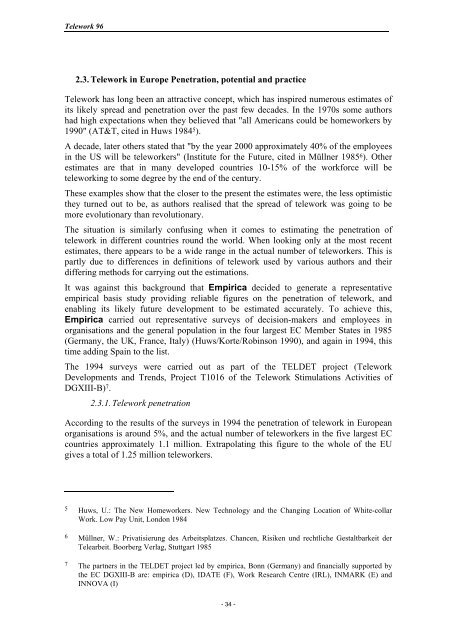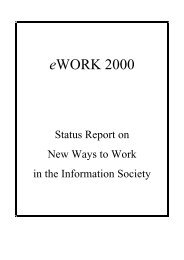1996 - European Telework Week
1996 - European Telework Week
1996 - European Telework Week
- No tags were found...
You also want an ePaper? Increase the reach of your titles
YUMPU automatically turns print PDFs into web optimized ePapers that Google loves.
<strong>Telework</strong> 96<br />
2.3. <strong>Telework</strong> in Europe Penetration, potential and practice<br />
<strong>Telework</strong> has long been an attractive concept, which has inspired numerous estimates of<br />
its likely spread and penetration over the past few decades. In the 1970s some authors<br />
had high expectations when they believed that "all Americans could be homeworkers by<br />
1990" (AT&T, cited in Huws 1984 5 ).<br />
A decade, later others stated that "by the year 2000 approximately 40% of the employees<br />
in the US will be teleworkers" (Institute for the Future, cited in Müllner 1985 6 ). Other<br />
estimates are that in many developed countries 10-15% of the workforce will be<br />
teleworking to some degree by the end of the century.<br />
These examples show that the closer to the present the estimates were, the less optimistic<br />
they turned out to be, as authors realised that the spread of telework was going to be<br />
more evolutionary than revolutionary.<br />
The situation is similarly confusing when it comes to estimating the penetration of<br />
telework in different countries round the world. When looking only at the most recent<br />
estimates, there appears to be a wide range in the actual number of teleworkers. This is<br />
partly due to differences in definitions of telework used by various authors and their<br />
differing methods for carrying out the estimations.<br />
It was against this background that Empirica decided to generate a representative<br />
empirical basis study providing reliable figures on the penetration of telework, and<br />
enabling its likely future development to be estimated accurately. To achieve this,<br />
Empirica carried out representative surveys of decision-makers and employees in<br />
organisations and the general population in the four largest EC Member States in 1985<br />
(Germany, the UK, France, Italy) (Huws/Korte/Robinson 1990), and again in 1994, this<br />
time adding Spain to the list.<br />
The 1994 surveys were carried out as part of the TELDET project (<strong>Telework</strong><br />
Developments and Trends, Project T1016 of the <strong>Telework</strong> Stimulations Activities of<br />
DGXIII-B) 7 .<br />
2.3.1. <strong>Telework</strong> penetration<br />
According to the results of the surveys in 1994 the penetration of telework in <strong>European</strong><br />
organisations is around 5%, and the actual number of teleworkers in the five largest EC<br />
countries approximately 1.1 million. Extrapolating this figure to the whole of the EU<br />
gives a total of 1.25 million teleworkers.<br />
5 Huws, U.: The New Homeworkers. New Technology and the Changing Location of White-collar<br />
Work. Low Pay Unit, London 1984<br />
6 Müllner, W.: Privatisierung des Arbeitsplatzes. Chancen, Risiken und rechtliche Gestaltbarkeit der<br />
Telearbeit. Boorberg Verlag, Stuttgart 1985<br />
7 The partners in the TELDET project led by empirica, Bonn (Germany) and financially supported by<br />
the EC DGXIII-B are: empirica (D), IDATE (F), Work Research Centre (IRL), INMARK (E) and<br />
INNOVA (I)<br />
- 34 -








